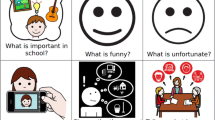Abstract
Specific biological, psychological, and social factors have been recorded throughout history as affecting the vulnerability of children. Taking these factors into account, the bioethical values of beneficence, non-maleficence, justice, and autonomy are developed. The backbone of bioethics is respect for human dignity and human rights which necessarily include children’s rights.
Similar content being viewed by others
References
American Academy of Pediatrics, Committee on Bioethics, (2009). Policy Statements: Appropiate Boundaries in the Pediatrician-Family-patient Relationships: Managing the Boundaries. Retrieved June 27, 2014, from http://pediatrics.aappublications.org/contente/124/6/1685.full
American Medical Association, Council on Ethical and Judicial Affairs Code of Medical Ethics (2014). Retrieved June 24, from http://www.ama-assn.org//ama/pub/physician-resources/medical-ethics/code-medical-ethics
Bostick, N. A., Sade, R., McMahon, J. W., & Benjamin, R. (2006). Report of the American Medical Association Council on Ethical and judicial affairs: withholding information from patients: rethinking the propriety of therapeutic privilege. The Journal of Clinical Ethics, 17(4), 302–306. 27 July 2014.
Coleman, L. D., & Rosoff, P. M. (2013). The legal authority of mature minors to consent to general medical treatment. Pediatrics 131, 786. Originally published online 25 Mar 2013. doi:10.1542/peds.2012-2470. Retrieved from http://pediatrics.aappublications.org/content/131/4/786.full.pdf
Council for International Organizations of Medical Sciences (CIOMS), (2002). International Ethical Guidelines for Biomedical Research Involving Human Subjects, ISBN 92 9036 075 5. http://www.cioms.ch/images/stories/CIOMS/guidelines/guidelines nov 2002 blur b.htm
Dwyer, J. G., (2008). Book review of the best interests of the child in healthcare. Faculty Publications. Paper 1509. Retrieved from http://scholarship.law.wm.edu/facpubs/1509
Edwin A.K., 2008, Don’t lie but don’t tell the whole truth: the therapeutic privilege - is it ever justified? Ghana Medical Journal, 12(4), 156–161. Retrieved from http://www.ncbi.nlm.nih.gov/pmc/articles/PMC2673833/pdf/GMJ4204-0156.pdf
Goodyear, D. (1999). John Locke’s pedagogy. In M. Peters, P. Ghiraldelli, A. Zarni, C. Gibbons, & R. Heraud (Eds.), Encyclopaedia of philosophy of education (pp 1–6). Philosophy of Education Society of Australasia, Marilia, Brazil and Auckland, New Zealand
Halevy, A., & Brody, B. A. (1996). A Multi-institution collaborative policy on medical futility. JAMA, 276(7), 571–574. doi:10.1001/jama.1996.03540070067035. Retrieved from http://jama.jamanetwork.com/article.aspx?articleid=406788
Lago, P. M., Devictor, D., Piva, J .P., & Bergounioux, J. (2007). End-of-life care in children: The Brazilian and the international perspectives. Journal de Pediatria (Rio J), 83(2 Suppl), S109–116. Retrieved from http://www.jped.com.br/conteudo/07-83-S109/port.pdf
UNESCO. (2005). Universal declaration on bioethics and human rights 19 October 2005. Retrieved March 17, 2013 from United Nations Educational, Scientific and Cultural Organization, documents web site: http://portal.unesco.org/en/ev.php-URL_ID=31058&URL_DO=DO_TOPIC&URL_SECTION=201.html
UNESCO. (2013). Report of the international bioethics committee of UNESCO on the principle of respect for human vulnerability and personal integrity 2013. ISBN 978-92-3-001111-6. Retrieved May 6,2014 from United Nations Educational, Scientific and Cultural Organization, documents web site: http://www.unesco.org
UNICEF. (2014). Protecting children updated: 19 May 2014. Retrieved May 6, 2014 from United Nations Children’s Fund, Web site: http://www.unicef.org/crc/index_protecting.html. Accessed 5 June 2014.
United Nations. (1949). The universal declaration of human rights. Retrieved March 17, 2013 from United Nations, documents web site: www.un.org/en/documents/udhr/
United Nations (UN). (2013). Convention on the rights of the child adopted and opened for signature, ratification and accession by general assembly resolution 44/25 of 20 November 1989. Retrieved March 17, 2013 from United Nations, documents web site: http://www.ohchr.org/Documents/ProfessionalInterest/crc.pdf
United Nations Department of Economic and Social Affairs, (2013). The millennium development goals report 2013 (pp. 64). UN Department of Economic and Social Affairs. ISBN: 978 -92-1-10128 4-2. Retrieved March 17, 2013 from United Nations, Department of Economic and Social Affairs web site: https://www.unfpa.org/public/publications/pid/6090
Vargas-Rubilar, J. & Arán-Filippetti, V. (2014). Importancia de la parentalidad para el Desarrollo Cognitivo Infantil: una Revisión Teórica. Revista Latinoamericana de Ciencias Sociales, Niñez y Juventud, 12(1), 171–186. 15 June 2014 (Spanish).
Waterston, T., & Goldhagen, J. (2006). Why children’s rights are central to international child health. Archives of Disease in Childhood, 92, 176–180.
Further Readings
American Board of Pediatrics. (2013). Bioethics bibliography Ethics Committee. 8 July 2014. Retrieved August 7, 2014 from American Board of Pediatrics, Web site: https://www.abp.org
Ariès, P. (1960). El niño y la vida familiar en el Antiguo Régimen. Retrieved from http://201.147.150.252:8080/xmlui/bitstream/handle/123456789/1346/Texto%2015.pdf?sequence=1 (Spanish).
Harrison, C., Kenny, N. P., Sidarous, M., et al. (1997). Bioethics for clinicians: 9. Involving children in medical decisions. In Singer, P. A., Bioethics for clinicians, Series. University of Toronto Joint Centre for Bioethics. Canadian Medical Association Journal, 156(6). 6 June 2014.
Rousseau, J-J. (2004). Emile. Retrieved from Free Ebook The Project Gutenberg EBook www.gutenberg.org/ebooks/5427
Yeong Cheah, P., & Parker, M. (2013). Consent and assent in paediatric research in low-income settings BMC Medical Ethics 2014, 15, 22. doi:10.1186/1472-6939-15-22. Retrieved from http://www.biomedcentral.com/1472-6939/15/22
Acknowledgments
Amanda Gabster for her English revision and corrections.
Author information
Authors and Affiliations
Corresponding author
Editor information
Editors and Affiliations
Rights and permissions
Copyright information
© 2014 Springer Science+Business Media Dordrecht
About this entry
Cite this entry
Vergès, C. (2014). Children and Ethics. In: ten Have, H. (eds) Encyclopedia of Global Bioethics. Springer, Cham. https://doi.org/10.1007/978-3-319-05544-2_74-1
Download citation
DOI: https://doi.org/10.1007/978-3-319-05544-2_74-1
Received:
Accepted:
Published:
Publisher Name: Springer, Cham
Online ISBN: 978-3-319-05544-2
eBook Packages: Springer Reference Religion and PhilosophyReference Module Humanities and Social SciencesReference Module Humanities



